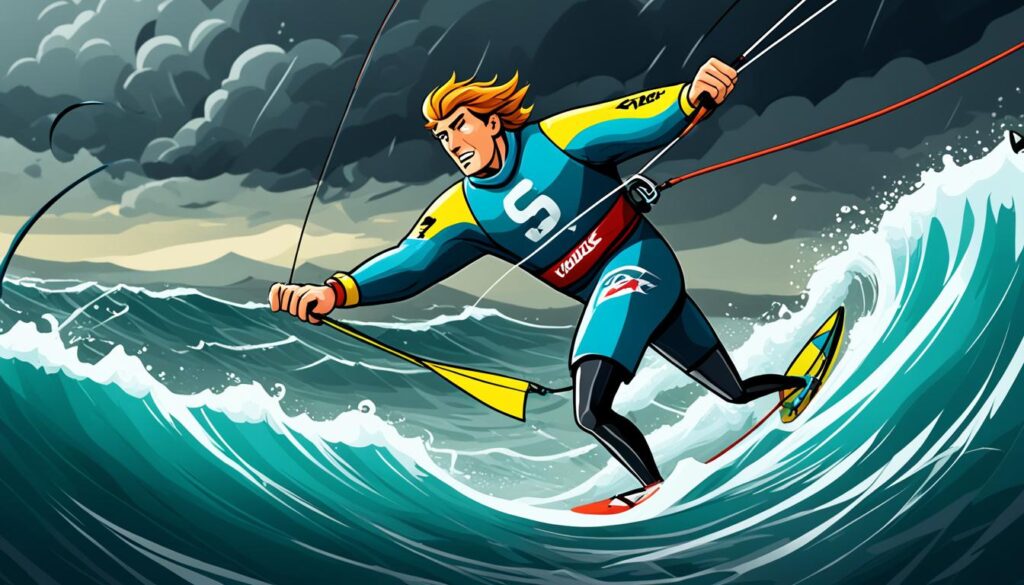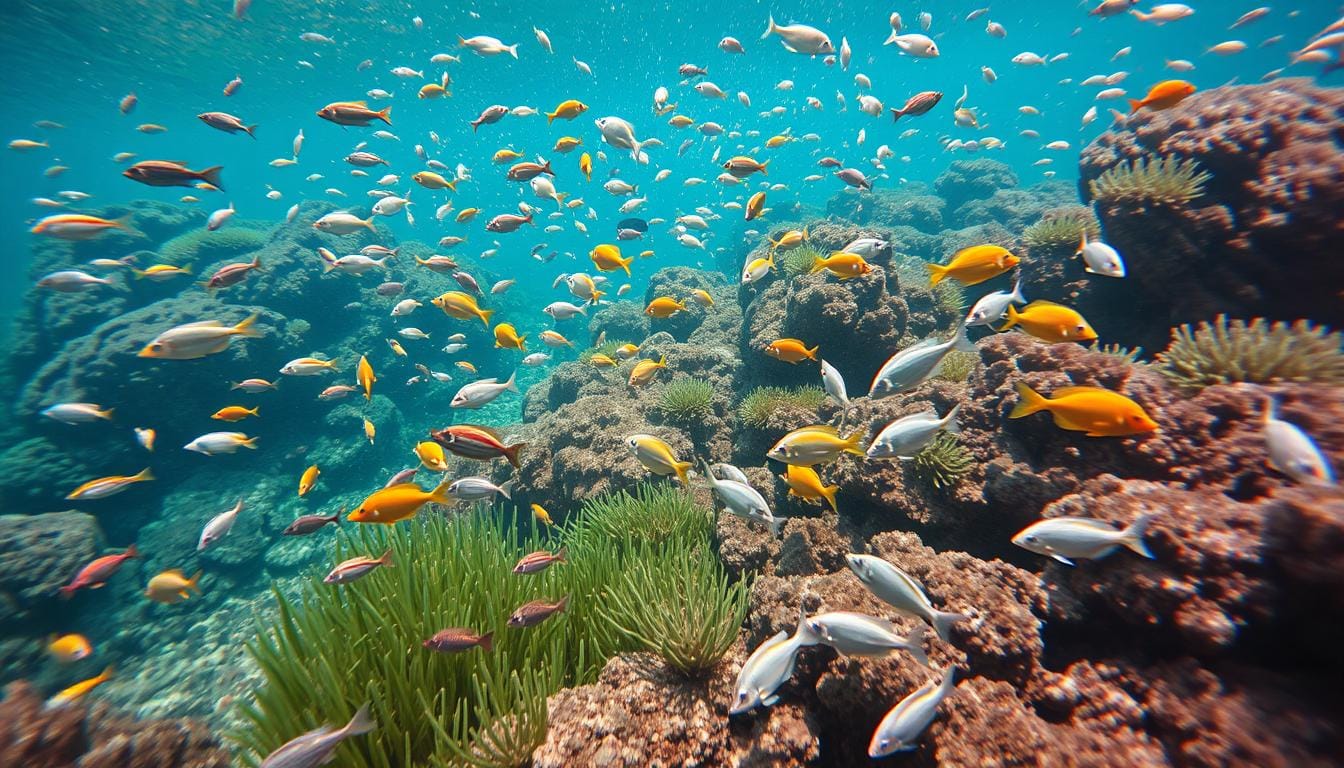About 70% of kite surfing accidents happen because of human mistakes. Not extreme weather or gear problems. Knowing the right kite surfing safety rules is key. This knowledge keeps everyone safe while enjoying the wind and waves.
Flying through the air with a kite is thrilling. But, it’s important to be safe. Learning the right kite surfing precautions is a must. It keeps the fun in balance with being careful.
Staying safe in kite surfing doesn’t mean less fun. It means you can keep having fun for a long time. By being smart and making good choices, you lower the risk of accidents. This makes every ride a beautiful dance with nature.
Table of Contents
ToggleKey Takeaways
- A majority of kite surfing accidents are due to human error, emphasizing the need for safety know-how.
- Familiarity with kite surfing precautions can significantly reduce the occurrence of common injuries.
- Adopting a proactive approach to kite surfing safety enhances one’s enjoyment and longevity in the sport.
- Education and respect for kite surfing dangers pave the way for a balance of freedom and responsibility on the water.
- Equipping oneself with necessary skills and safety measures is a crucial aspect of kite surfing etiquette.
Understanding the Risks of Kite Surfing
Kite surfing mixes speed and tricks above water but is not without risks. It leads to various injuries, accidents, and dangers. So, being well-prepared and aware is critical for anyone in this sport.
Common Kite Surfing Injuries and Accidents
Injuries in kite surfing vary from minor cuts to serious fractures and head trauma. These often happen because of gear issues, hitting others or objects, or mistakes made by surfers. Knowing about these risks can help people get ready and maybe prevent accidents.
Environmental Factors Contributing to Kite Surfing Perils
Weather changes, strong currents, and obstacles like rocks or buoys can make kite surfing very hazardous. It’s vital to be alert and show respect for nature to lower these risks.
Statistics on Kite Surfing Related Incidents
Incident data shows the serious dangers of kite surfing. By studying these stats, surfers and teachers can push for better safety rules. This could greatly decrease the number of accidents.
| Incident Type | Percentage | Common Causes |
|---|---|---|
| Cuts and Bruises | 30% | Collisions with Equipment/Others |
| Fractures | 25% | Collisions, Falls |
| Head Traumas | 15% | Impact with Surface, Equipment Failures |
| Other | 30% | Environmental Factors, Equipment Misuse |
Kite surfing is thrilling but risky, with potential for serious injuries. It’s key for fans to learn about these dangers and follow strict safety guidelines. This way, they can enjoy the sport with less risk.
The Importance of Proper Training
Trying kite surfing without learning first can lead to many kite surfing dangers for beginners. It’s key to reduce these dangers by learning from kite surfing schools. They are important for safe kite surfing.

Schools and Certification for Kite Surfing Beginners
For newbies, selecting a good kite surfing school marks the beginning. Known kite surfing schools offer step-by-step lessons. They teach from the basics to the advanced. This foundation in both skill and safety is key to avoiding kite surfing dangers for beginners.
Learning Weather Patterns and Kite Handling
Knowing the weather where you surf is critical for safety. Good kite handling skills and weather awareness lower accident chances. They also make your kite surfing more fun.
Evaluating the Role of Experience in Preventing Accidents
Experience is highly valuable in kite surfing. With experience, you get better at dealing with sudden changes in the wind and water. This keeps you safe from many kite surfing dangers. It shows the need to keep practicing and learning in kite surfing.
| Element | Impact on Safety |
|---|---|
| Professional Training | Equips beginners with necessary skills and safety protocols |
| Weather Knowledge | Crucial for anticipating and reacting to environmental conditions |
| Experience | Enhances decision-making and reduces accident rates |
Kite Surfing Dangers for Beginners
Starting kite surfing is exciting, but it carries kite surfing perils, especially for newbies. It’s important to know the kite surfing dangers for beginners. This ensures that safety (key in kite surfing safety) comes first. Newcomers face risks like wrong weather guesses, mistakes in how they handle things, and gear not working right. These can cause bad accidents or harm.

It’s smart to learn in a safe place and take it slow with a good teacher. This can really lower the chances of those dangers. First-timers should pick spots with light winds and not so deep water. These are easier places to get a hang of controlling the kite and moving correctly.
- Inadequate training leading to poor technique and accidents.
- Unpredictable weather changes causing unsafe surfing conditions.
- Equipment failures due to improper use or maintenance.
To see things more clearly, let’s compare what beginners often do wrong with what they should do:
| Common Beginner Error | Recommended Practice |
|---|---|
| Ignoring weather advisories | Regularly check weather updates and heed warnings |
| Using advanced equipment too soon | Start with beginner-friendly gear tailored to learning |
| Neglecting pre-surf equipment checks | Perform thorough inspections before each session |
Following these tips makes kite surfing fun but safer for beginners. So, keeping to kite surfing safety guidelines is crucial for a safe and fun start in the sport.
Equipment Checks: Minimizing Kite Surfing Hazards
Kite surfing is both thrilling and risky. Checking your gear well is as important as the sport itself. It helps keep you safe and your equipment in good shape. By being cautious, you can enjoy kite surfing more.
Pre-Flight Gear Inspection Routine
Every kite surfer must check their gear before hitting the waves. They start by looking for any kite damage. Then, they check the lines and make sure the harness works well. Each check reduces the chance of accidents. Always remember, safety is the top priority in this exciting sport.
The Lifespan of Kite Surfing Equipment
Even the best gear wears out from sun and salt. It’s crucial to know when to get new equipment. Keeping an eye on your gear’s condition is key. Timing is everything. You must check your gear often to safeguard your rides.
Mandatory Safety Features and Upgrades
Having the latest safety gear is a must. Today’s tech brings new ways to stay safe. Quick-release systems, impact vests, and helmets are making kite surfing safer. Upgrading your gear with the latest in safety not only improves your time on the water but also keeps you better protected.
Equipment Checks: Minimizing Kite Surfing Hazards
What are some common kite surfing injuries and accidents?
Kite surfers face a variety of injuries like cuts, bruises, and head traumas. These happen for a few reasons. There might be a fault in the equipment. Sometimes, it’s the surfer’s mistake. Or harsh weather could cause a loss of control or a crash.
How do environmental factors contribute to kite surfing perils?
Things like weather, currents, and rocks can make kite surfing more dangerous. It’s key to look at these factors closely. This is to make sure you’re safe before you go out.
Are there any statistics on kite surfing related incidents?
Yes, the data shows that many accidents come from not enough training or ignoring the weather. Equipment failures also play a big part. This highlights the urgent need for safety awareness.
Why is proper schooling and certification important for kite surfing beginners?
Certified training teaches beginners the basics and how to stay safe. This reduces the risk of accidents and injuries in the sport.
How critical is it to learn weather patterns and kite handling?
It’s essential to know the weather and be good at controlling your kite. This keeps you safe by making smart decisions and handling your gear the right way.
What role does experience play in preventing kite surfing accidents?
Experience in different conditions helps keep kite surfers safe. It lets them spot dangers early and know how to avoid accidents.
What specific risks should new kite surfers be aware of?
Beginners need to avoid strong winds, deep water, and crowded spots. They could lose control of the kite. It’s vital for them to learn in safe, easy places.
What does a pre-flight gear inspection routine involve?
Checking your gear means looking at the kite, lines, control bar, and safety systems. Make sure everything is in good shape.
How can you determine the lifespan of kite surfing equipment?
Equipment life varies. Keep an eye out for wear and tear, such as frayed lines. If gear is getting old, replace it soon.
What mandatory safety features and upgrades should be present in kite surfing gear?
Safety gear should include things like quick-release systems, leashes, and vests. Better control systems and materials also reduce risks.






Μία Απάντηση
Find an abundance of fascinating and valuable materials here .
Whether you’re into expert articles to quick tips , you’ll find for everyone .
Keep updated with curated resources built to assist plus entertain visitors.
This site offers a seamless experience easily discover resources you need .
Connect with of like-minded individuals and benefit from reliable content consistently.
Start exploring today and discover wealth of knowledge our site has to offer .
https://banyuwangi.us